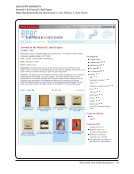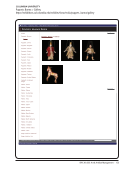16 · Survey Results: Executive Summary
indicate that only a very few ARL special collections
have adopted the museum community’s metadata
standards, VRA Core (9% for art 4% for artifacts)
and Categories for the Description of Works of Art
(4% for both art and artifacts), for either category of
object. Metadata standards are used nevertheless,
particularly for artifacts 82% of respondents indicated
they use EAD, 62% use MARC, and 53% use Dublin
Core. These standards are also widely used for art
collections (67% EAD, 51% MARC, and 38% Dublin
Core). Metadata standards are an area where libraries,
archives, and museums have many opportunities to
collaborate more closely in the future.
Challenges and Successes
The survey invited respondents to list up to three chal-
lenges and three successes in managing art or artifact
collections. Several themes emerged, particularly for
challenges. These themes are areas for further research
and collaboration in our community.
The extent to which storage and other space con-
cerns were expressed is remarkable. The survey de-
signers specifically excluded questions about physical
arrangement and storage in order to focus on intel-
lectual access. However, of the 63 responses to this
question, 49 (77%) noted proper and adequate space
for storage, use, or processing as a challenge more-
over, 34 listed this as their first challenge. The second
most mentioned challenge was preservation/con-
servation, with 34 institutions (53%) listing this. The
comments in the survey suggest the potential broad
scope of this problem, going beyond available square
footage, to concerns like the challenge of storage in a
space that was designed for books and archival ma-
terials to lack of exhibit capacity to conservators who
are trained primarily for paper and books. A critical
finding of this survey was the extremely high fre-
quency at which ARL institutions noted the physical
circumstances of their art and artifact collections as a
challenge the authors hope that additional work will
be done to assess space and preservation/conserva-
tion needs.
Other themes that emerged in the challenges sec-
tion were categorized as lack of resources (21 respon-
dents), intellectual control (20), access (17), and train-
ing/expertise (13).
To group together aspects of resources and train-
ing/expertise, institutions expressed concerns about
either the number of staff available to do the work
or the knowledge of those staff to deal with art and
artifact collections if their expertise was in other ar-
eas of librarianship or preservation, for example. The
survey gathered data on staffing levels for the spe-
cial collections responding and found a wide range.
At the minimum, one institution reported a single
individual at 0.4 full time equivalence (FTE) at the
maximum, another institution employs 95 individu-
als at 87 FTE. The mean was 12.6 individuals at 10.4
FTE. Comments on staff suggest many institutions
use student assistants and temporary employees for
management of art and artifact collections. Many also
indicated inadequate staffing to meet the processing
description needs of these types of objects. Other
resources, such as supplies, space, funding, and rec-
ognition were identified as important as well.
Of particular interest to this study were the chal-
lenges reported around intellectual control and ac-
cess. In the category of intellectual control, many
respondents mentioned that the lack of descriptive
and metadata standards for art and artifacts makes
it difficult to execute the work. A few noted that even
if such standards came into common use, legacy data
not based on standards would be a challenge. Several
institutions noted problems with access, in that exist-
ing systems may make inadequate use of existing
description or that potential users have no access to
these systems. In some cases, access is also hindered
by condition of the objects, lack of appropriate re-
search space, or other concerns.
Respondents reported many successful strategies
that are the counterpoints to the challenges that were
raised. Digitization, proper housing, and successes of
providing description in a variety of settings were all
significant accomplishments. Both item and collection
level description were mentioned as successes, but a
more generalized conclusion could be that provid-
ing any intellectual access is better than none. Many
respondents had success with providing thumbnail
images with the metadata describing the physical
objects, which made it easier for both staff and re-
searchers to access and use the materials. Appropriate
housing and clear labeling were also reported as a
indicate that only a very few ARL special collections
have adopted the museum community’s metadata
standards, VRA Core (9% for art 4% for artifacts)
and Categories for the Description of Works of Art
(4% for both art and artifacts), for either category of
object. Metadata standards are used nevertheless,
particularly for artifacts 82% of respondents indicated
they use EAD, 62% use MARC, and 53% use Dublin
Core. These standards are also widely used for art
collections (67% EAD, 51% MARC, and 38% Dublin
Core). Metadata standards are an area where libraries,
archives, and museums have many opportunities to
collaborate more closely in the future.
Challenges and Successes
The survey invited respondents to list up to three chal-
lenges and three successes in managing art or artifact
collections. Several themes emerged, particularly for
challenges. These themes are areas for further research
and collaboration in our community.
The extent to which storage and other space con-
cerns were expressed is remarkable. The survey de-
signers specifically excluded questions about physical
arrangement and storage in order to focus on intel-
lectual access. However, of the 63 responses to this
question, 49 (77%) noted proper and adequate space
for storage, use, or processing as a challenge more-
over, 34 listed this as their first challenge. The second
most mentioned challenge was preservation/con-
servation, with 34 institutions (53%) listing this. The
comments in the survey suggest the potential broad
scope of this problem, going beyond available square
footage, to concerns like the challenge of storage in a
space that was designed for books and archival ma-
terials to lack of exhibit capacity to conservators who
are trained primarily for paper and books. A critical
finding of this survey was the extremely high fre-
quency at which ARL institutions noted the physical
circumstances of their art and artifact collections as a
challenge the authors hope that additional work will
be done to assess space and preservation/conserva-
tion needs.
Other themes that emerged in the challenges sec-
tion were categorized as lack of resources (21 respon-
dents), intellectual control (20), access (17), and train-
ing/expertise (13).
To group together aspects of resources and train-
ing/expertise, institutions expressed concerns about
either the number of staff available to do the work
or the knowledge of those staff to deal with art and
artifact collections if their expertise was in other ar-
eas of librarianship or preservation, for example. The
survey gathered data on staffing levels for the spe-
cial collections responding and found a wide range.
At the minimum, one institution reported a single
individual at 0.4 full time equivalence (FTE) at the
maximum, another institution employs 95 individu-
als at 87 FTE. The mean was 12.6 individuals at 10.4
FTE. Comments on staff suggest many institutions
use student assistants and temporary employees for
management of art and artifact collections. Many also
indicated inadequate staffing to meet the processing
description needs of these types of objects. Other
resources, such as supplies, space, funding, and rec-
ognition were identified as important as well.
Of particular interest to this study were the chal-
lenges reported around intellectual control and ac-
cess. In the category of intellectual control, many
respondents mentioned that the lack of descriptive
and metadata standards for art and artifacts makes
it difficult to execute the work. A few noted that even
if such standards came into common use, legacy data
not based on standards would be a challenge. Several
institutions noted problems with access, in that exist-
ing systems may make inadequate use of existing
description or that potential users have no access to
these systems. In some cases, access is also hindered
by condition of the objects, lack of appropriate re-
search space, or other concerns.
Respondents reported many successful strategies
that are the counterpoints to the challenges that were
raised. Digitization, proper housing, and successes of
providing description in a variety of settings were all
significant accomplishments. Both item and collection
level description were mentioned as successes, but a
more generalized conclusion could be that provid-
ing any intellectual access is better than none. Many
respondents had success with providing thumbnail
images with the metadata describing the physical
objects, which made it easier for both staff and re-
searchers to access and use the materials. Appropriate
housing and clear labeling were also reported as a


















































































































































































